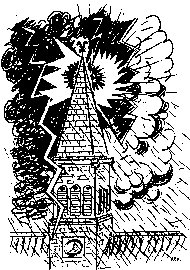The Tower Handbook
14.11 Safety
a: What precautions should I take when doing maintenance?
 Don't try to be a macho Jack-the-Lad (or Jill-the-Lass?) when working among bells. First and foremost don't work on the bells alone, take someone with you even if only as company. If you must work alone, do tell someone where you are and when you expect to get back. If you have a mobile phone, it might be worth taking it along.
Don't try to be a macho Jack-the-Lad (or Jill-the-Lass?) when working among bells. First and foremost don't work on the bells alone, take someone with you even if only as company. If you must work alone, do tell someone where you are and when you expect to get back. If you have a mobile phone, it might be worth taking it along.
Wear sensible non-slip shoes. If you are doing anything which involves dust, such as general cleaning up, or rust removal then wear a mask. If you're removing rust then goggles are a good idea too. A hard hat is a worthwhile bit of kit especially if your frame is cramped or access is difficult. Don't rule out gloves as cissy. Remember that trapping your knuckles between a slipping spanner and a frame is not a lot of fun. Gloves may not cut down the bruises, but they should reduce the blood loss!
Remember – Injuries can happen
Remember that adequate illumination is essential for working on bells. A wander lamp is very useful, but make sure that the cable and plugs are in good condition. You could consider an earth leakage circuit breaker in the supply to the lamp, or a low voltage wander lamp. When using it be careful not to make a cat's cradle as you clamber about the frame clutching your lamp as you go, with its cable wrapping round every headstock.
b: What should we do about lighting?
Tower lighting falls broadly into three categories, stairs, ringing room and bell chamber. There is a case for having all lights that are not regularly used (eg upper stairs, clock chamber and bell chamber) on a single switch to help prevent leaving one on by accident. If there is a warning light in the switch this will help too. Make sure that all lamps are replaced when necessary, and if any faults develop tell the responsible church authorities immediately. Repair and maintenance of electrical fittings must be carried out by a qualified electrician, or the church's insurance may be invalidated.
c: Is the lighting in our tower adequate?
Is there sufficient lighting in everywhere it is needed, especially in the bell chamber which is often neglected? Are switches obvious and readily accessible? Could anyone accidentally switch off all the tower lighting? This could be dangerous,, especially from places in the church regularly accessible by non ringers. If there are any master switches accessible outside the tower have they got warning notices attached? Is there any form of emergency lighting? If you are not happy, get something done. Ideally the church would arrange for the necessary changes to be made, but even if that is not possible, you may be able to arrange for a cheaper interim solution, eg warning notices, local emergency lights or rechargeable torches.
d: What about emergency lighting?
This really is an essential, especially in the ringing room, but it is much less common than it ought to be. Hard wired installations are definitely a job for a professional, but you can get reasonably priced plug-in lights. You can rig one of these up without requiring an electrician, since it plugs into a standard 13 amp socket. It contains a battery that is charged when the power is on and powers an emergency light when the power fails. Remember to test emergency lighting from time to time (and make sure no one has 'borrowed' it for some reason).
e: What should we do about access to tower and bell chamber?
Keep your stairs clean, since dust and grit can be dangerously slippery. This is especially important if your steps have worn and are sloping. If they are badly worn, = consider having them repaired. Check ladders and hand rails from time to time. Do you have adequate hand rails? You should, or at the very least there should be a rope for support. Is the tower secure against unauthorised entry by members of the general public? Unlocked doors, or keys underneath a mat or hymn book will not keep out a mischievous youngster. It is particularly important to make sure no one can get into the bell chamber without adequate supervision.
f: Do we need to worry about the lightning conductor?
 The protection of the church against lightning is not the ringers' responsibility, but as occupants of the highest part of the building ringers have a vested interest in the lightning protection working properly.
The protection of the church against lightning is not the ringers' responsibility, but as occupants of the highest part of the building ringers have a vested interest in the lightning protection working properly.
The tower should have a lightning conductor and because of its position, the (metal) bell frame should also be earthed by a heavy metal strap (ideally by two independent ones). If you notice the connection is loose or looks suspect you should tell someone. For further information see the advice published by the Central Council Towers and Belfries Committee in The Ringing World 24th May 1996, p531.
Previous

 Next
Next
Currently hosted on jaharrison.me.uk
 Don't try to be a macho Jack-the-Lad (or Jill-the-Lass?) when working among bells. First and foremost don't work on the bells alone, take someone with you even if only as company. If you must work alone, do tell someone where you are and when you expect to get back. If you have a mobile phone, it might be worth taking it along.
Don't try to be a macho Jack-the-Lad (or Jill-the-Lass?) when working among bells. First and foremost don't work on the bells alone, take someone with you even if only as company. If you must work alone, do tell someone where you are and when you expect to get back. If you have a mobile phone, it might be worth taking it along. The protection of the church against lightning is not the ringers' responsibility, but as occupants of the highest part of the building ringers have a vested interest in the lightning protection working properly.
The protection of the church against lightning is not the ringers' responsibility, but as occupants of the highest part of the building ringers have a vested interest in the lightning protection working properly.